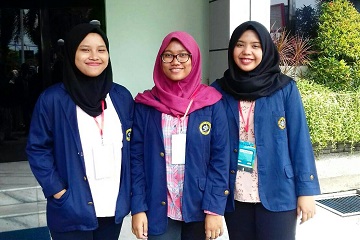Cell-Foam: Eco Friendly Packaging as Styrofoam Substitute Invented by IPB Students

Styrofoam is a common packaging which widely used as container for various product in Indonesia. Unwittingly styrofoam usage has become a quite large contributor of domestic waste. Styrofoam itself is one of polystyrene products that is difficult to be disintegrated.
This problem has been unsettled a group of students from Bogor Agricultural University (IPB). Ghanis Andari Putri, Nela Rifda Nur Millatina, and Wenita Firliani from Department of Food Science and Technology, Faculty of Agricultural Technology. This team initiated the idea of making styrofoam that can be disintegrated easily in nature named “Cell-Foam”. This idea is realized into Student Creativity Program of Exact Science Research field (PKM-PE) under supervision of Dr. Nugraha Edhi Suyatma, S.TP, DEA. The research titled “Cell-Foam: Nanocellulose Extraction from Waste Paper Sludge and Its Application in Bionanocomposite Foam”.
Foam Cellulose which is shortened to Cell-Foam is a container made of natural material that is easy to decompose in nature. Cell-Foam comes as an alternative that can be used to substitute styrofoam which is difficult to decompose. Moreover, styrofoam making process uses chlorofluorocarbon gas (CFC) which is one contributor in causing global warming.
“This Cellulose Foam, which is shortened as Cell-Foam, is made of cellulose extraction from paper waste and transform it into nano size. We choosed to utilize waste from used paper sludge as material of Cell-Foam. Result of the test we conducted, Cell-Foam that we made is degradable and can be decomposed in 15 days and also many earthworms feed on it. Whereas common styrofoam sold in market, its shape is still intact and cannot be decomposed at all. Cell-Foam is suitable to be used as environmentally friendly packaging for electronic goods,” said the Team Leader, Gharnis Andari Putri.
“Data obtained from Bandung, West Java, has shown the high quantity of styrofoam waste that is 21.769 tons/month. That data is from Bandung only, not yet accumulated with other areas. Styrofoam has became one of big waste contributors and it is non degradable. So that we create this Cell-Foam as a proposed alternative to reduce non degradable styrofoam waste,” said one of team member, Nela Rifda Nur Millatina.
Cell-Foam is made as environmentally friendly packaging. Cell-Foam can be decomposed in days. Moreover, this team use paper waste to reduce waste from used paper. “Cell-Foam making is the first step we took in order to replace styrofoam as non degradable packaging,” conveyed on of team member, Wenita Firliana.
Nanocellulose, the main material in Cell-Foam making, is produced from paper waste. Nanocellulose can improve mechanical properties, such as excellent rigidity and compressive strength of Cell-Foam made by this team.
Cell-Foam making is conducted to increase Indonesia people awareness so they will be more care about styrofoam waste. Small things starts from reducing styrofoam usage can be carried out to decrease the accumulation of non degradable waste in nature. Further research about Cell-Foam is required so it can really replace styrofoam role as packaging for various products. (qa)


